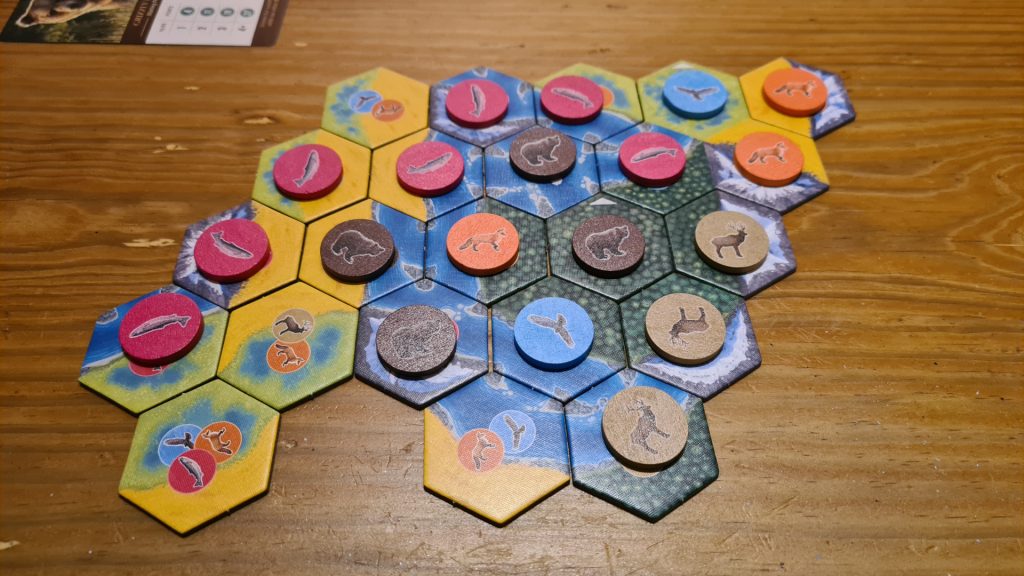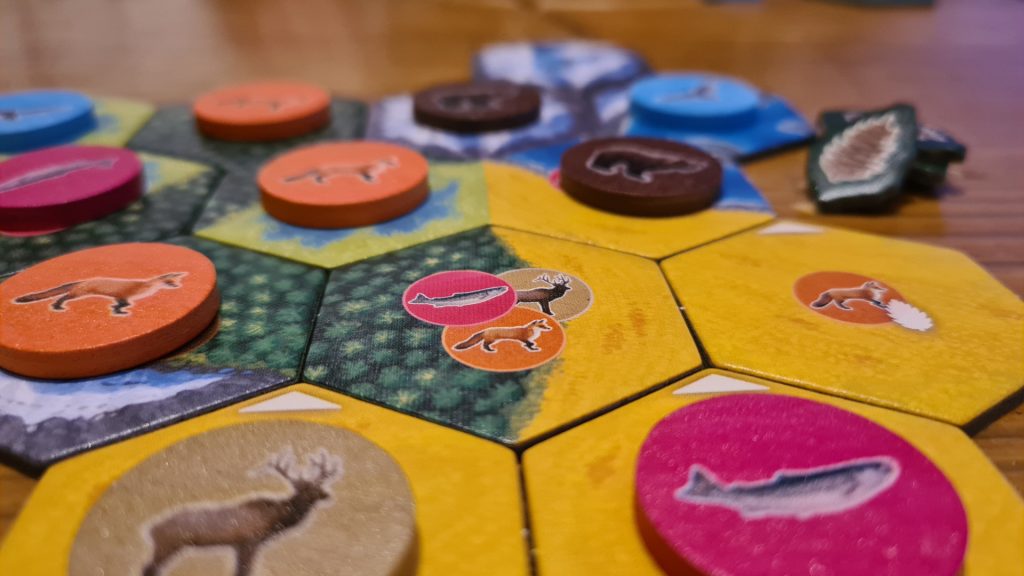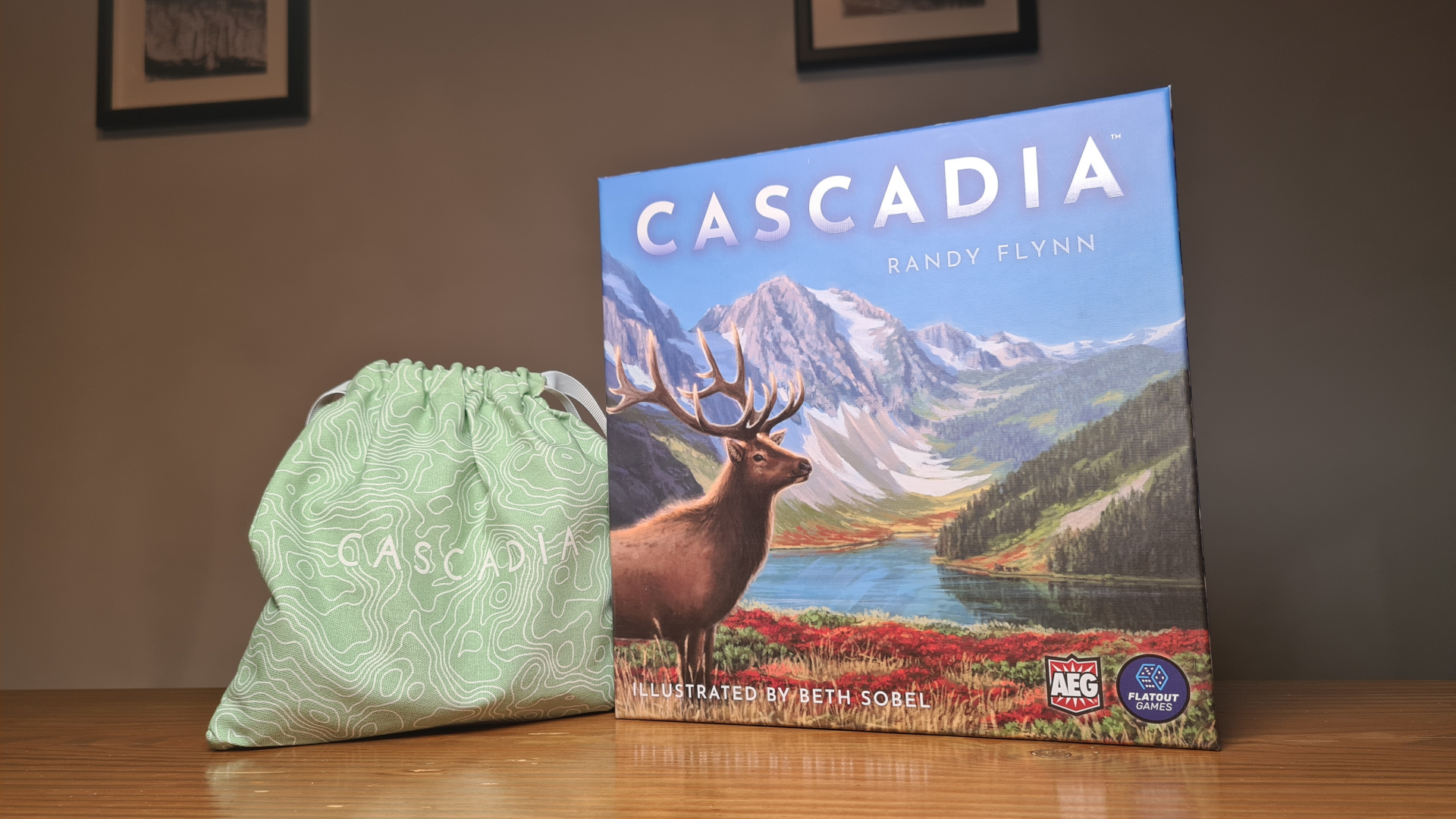Cascadia is the brand new hexagon tiles based board game from Flatout Games. Designed by Randy Flynn, featuring artwork from Beth Sobel, the game sees 1 – 4 players build out habitats and wildlife, from mountains to wetlands. Hot off the back of Calico, the cat themed tile placement title, the game again features tile drafting and lasts around 30 minutes. However, is the swap from cats to multiple animals part of a bigger improvement? Let’s find out!
Setup doesn’t take long at all and is mostly about instilling variety into the game. Tipping all of the wildlife tokens into the cloth bag, randomly selecting the number of habitat tiles for the player count and 1 scoring card for each of the five animal types is almost the extent of setup. Taking a starting habitat tile, placing it in front of themselves, players then just need to make the starting market – a row of 4 habitat tiles and beneath a row of 4 wildlife tokens.
Randomly choosing the first player, turns follow a very simple order. At the start of a turn if all four wildlife tokens match they are discarded, with new tokens pulled form the bag. If only 3 are the same the active player can choose to discard the three, which are then replaced. Before choosing a tile and token pair the player can choose to spend a nature token to wipe any number of the current wildlife tokens, again replacing them. Often all this is skipped, but it becomes important when players really want specific animals.
The active player then can either claim one of the paired up habitat tiles and wildlife tokens or spend a nature token to take any combination of tile and token. They then place the tile and the token into/onto their environment – in either order. Habitat tiles must be placed adjacent to previous tiles in your environment, including the starting habitat tile. Habitat tiles depict different habitats. Sides of the tiles don’t have to match when placed, though you will most likely want them to for end game scoring.
Each habitat tile also depicts 1 – 3 animals, which are the wildlife tokens that can be placed there. While keystone tiles only have 1 wildlife symbol, making them harder to fulfill, when a player does place the corresponding token onto a keystone tile they gain a nature token to spend however they like on a future turn. Once the player has finished placing they refill the market for the next player.

Points are of course the aim of the game and there are multiple ways to score in Cascadia. At the end of the game, which triggers when everyone has placed 20 tiles into their environment, players score each habitat type. Counting the number of tiles a contiguous habitat corridor spans scores them that number of points. Plus, for each habitat type, the player who has the largest corridor scores bonus points.
The wildlife tokens earn points based on the scoring cards selected at the start of the game. In one game foxes may want to be surrounded by different species, while hawks want to be adjacent to anything but other hawks. In the next game, foxes might want to be next to as many tokens of only one wildlife type. Scoring all this up, and gaining one point per unspent nature token, whomever has the most points wins!
Explaining how to play Cascadia takes a minute, allowing the game to hit the table extremely fast. Of course after this minute players will want to know how to score. With 4 different scoring cards included for each animal the variations are huge, though explaining them isn’t a huge ask. They generally follow similar paths to points, perhaps scoring slightly differently for a different length of run or straight of the same animal. The hawks do have the potential to be the trickiest to teach, with them often being about distances between hawks, though after one game these are clear to players. Having clear objectives means that players aren’t left working out how to score, only to determine a way to score big!
Unlike last year’s Calico which felt like a brain burning puzzle, Cascadia is much more of a pleasant puzzle, that can be played after a long day and still be enjoyed. Part of the reason for this is the lack of a border. Not having the constriction of an edge means that what could have forced you to place a tile in a space you were hoping to save no longer exists; just place it adjacent to any other tile and keep that space free for that ideal habitat tile you’re holding out for. It’s a simple change but one that feels more forgiving and lets you keep that hope, without pressuring you into a forced placement.
What you do on your turn might be the same but each game of Cascadia is different from the last. Different tiles are used, which is something more obvious with lower player counts, and the order that tiles and tokens enter the market is never the same. These alone drag players in different directions, going for runs of salmon or pairs of bears. Changing up the perceived value of those tiles and more though are the changing scoring objectives for the animals. Combining these allows the game to feel fresh and different enough to play two or more games back to back.

During play, what’s available in the market changes a lot. Even with 2 players your opponent might burn through nature tokens to get the wildlife token they want, before taking a pair. This means the choice of tile and token pairs can be completely different when play gets back to you. While you can eye up a pair you hope to take, it does mean that often it isn’t until your turn that you actually know what you can pick from. With more than 2 players it almost becomes pointless looking at the market until the player before you in turn order is up. If you’re easily distracted from games this time could be enough to see you lose immersion in the game.
For the most part the production quality of Cascadia is extremely high. The tiles are clear to read but they haven’t compromised creating a visually pleasing map of terrain in front of players. The wildlife tokens are nice wooden chips, pulled out of an included cloth drawstring bag. This not only makes setup, teardown and storing the game better, it also adds to the quality of the game.
The only minor downside is that the tokens only have the animals printed on one side. Each is a distinct colour, though for colourblind users there is nothing else to distinguish them if face down. Even for those who aren’t colourblind, it means you have to flip every upside down token that comes out of the bag for the first game or two. It’s a tiny grievance but one none-the-less.
It is clear to see why many have been tooting Cascadia’s horn. The rules are extremely simple, allowing the game to instantly hit the table. There are a load of ways to score points, so even if you don’t win you’ll have been able to rack up points for something – even just placing tile out which is a mandatory part of the turn. There’s variety from the way the tiles and tokens enter the market and then the wildlife scoring cards just tweak things to keep the objectives fresh from one play to the next. Calico is certainly the brutal brother, as Cascadia is more of a joy to play, with more gamers able to enjoy it.
(Editor’s Note: Cascadia was provided to us by Asmodee for the review. The game is currently available from local board game stores! Find your local store here.)

